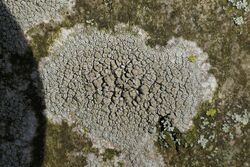Biology:Glaucomaria carpinea
| Glaucomaria carpinea | |
|---|---|

| |
| Scientific classification | |
| Domain: | Eukaryota |
| Kingdom: | Fungi |
| Division: | Ascomycota |
| Class: | Lecanoromycetes |
| Order: | Lecanorales |
| Family: | Lecanoraceae |
| Genus: | Glaucomaria |
| Species: | G. carpinea
|
| Binomial name | |
| Glaucomaria carpinea (L.) S.Y.Kondr., Lőkös & Farkas (2019)
| |
| Synonyms[1] | |
|
List
| |
Glaucomaria carpinea is a species of corticolous (bark-dwelling), crustose lichen in the family Lecanoraceae.[2] It is a widely distributed species.
Taxonomy
The lichen was first scientifically described by Carl Linnaeus in 1753.[3] It has had a complex taxonomic history, and has been transferred to several genera, including Lecanora, Scutellaria, and Variolaria. It is synonymous with Lichen angulosus, as defined by Johann Christian Daniel von Schreber in 1771, and all of the names resulting from generic transfers of that taxon.[1] Sergey Kondratyuk, László Sándor Lőkös, and Edit Farkas transferred it to the genus Glaucomaria in 2019.[4]
Description
Glaucomaria carpinea has a crust-like (crustose) thallus that is either continuous or cracked. It has a whitish to grey colour, with a smooth texture and is not covered with a powdery substance ([[Glossary of lichen terms#{{biology:{1}}}|{{Biology:{1}}}]]). This lichen is sometimes bordered by a white growth (prothallus) at its edges. Its apothecia (fruiting bodies) are typically crowded together and can be round or angular due to mutual compression. These apothecia are flat or slightly convex, measuring 0.5–1.5 mm across, and have an orange-brown to flesh-coloured [[Glossary of lichen terms#{{biology:{1}}}|{{Biology:{1}}}]] heavily covered in white [[Glossary of lichen terms#{{biology:{1}}}|{{Biology:{1}}}]]. The margin of the apothecia is thin, slightly prominent, and typically not wavy.[5]
The outer ring of the apothecia (the [[Glossary of lichen terms#{{biology:{1}}}|{{Biology:{1}}}]]) features a well-developed [[Glossary of lichen terms#{{biology:{1}}}|{{Biology:{1}}}]] composed of vertically aligned hyphae (an [[Glossary of lichen terms#{{biology:{1}}}|{{Biology:{1}}}]] arrangement), with a medulla containing crystals that dissolve in a solution of potassium hydroxide (K). The inner ring ([[Glossary of lichen terms#{{biology:{1}}}|{{Biology:{1}}}]]) is thin and colourless, also filled with K-soluble crystals. The [[Glossary of lichen terms#{{biology:{1}}}|{{Biology:{1}}}]] (topmost layer of the apothecia) is pale brown with a layer of fine crystals, with both the pigment and crystals dissolving in K to produce a bright yellow colour change (C+ bright yellow). The hymenium, the spore-producing layer, is colourless and 50–70 µm high. The paraphyses (sterile filaments in the hymenium) are slightly thickened at the top. The layer below the hymenium ([[Glossary of lichen terms#{{biology:{1}}}|{{Biology:{1}}}]]) is colourless.[5]
The asci (spore-bearing cells) of Glaucomaria carpinea are elongated-club shaped (elongate-[[Glossary of lichen terms#{{biology:{1}}}|{{Biology:{1}}}]]) and very thin-walled, containing eight spores each. These asci have a tall structure in the middle ([[Glossary of lichen terms#{{biology:{1}}}|{{Biology:{1}}}]]) that reacts to iodine and potassium hydroxide by turning blue (K/I+ blue), surrounded by a blue outer layer. The [[Glossary of lichen terms#{{biology:{1}}}|{{Biology:{1}}}]] are single-celled, hyaline (translucent), simple, broadly ellipsoid, and measure 9–14.5 by 5–8.5 µm with a thin wall. The [[Glossary of lichen terms#{{biology:{1}}}|{{Biology:{1}}}]], the photosynthetic partner of the lichen, is [[Glossary of lichen terms#{{biology:{1}}}|{{Biology:{1}}}]]–a spherical green alga.[5]
Chemical tests on the thallus reveal a yellow reaction to the K spot test (K+ yellow) and contain atranorin as the major compound, with minor amounts of chloroatranorin and eugenitol. The pruina on the apothecial disc contains a major metabolite called sordidone.[5] Glaucomaria carpinea has been noted to be a morphologically variable species, particularly in the deposition of pruina on various surfaces and the thickness of the margins. However, the lichen tends to be anatomically and chemically uniform.[6]
Habitat and distribution
Glaucomaria carpinea has a nearly cosmopolitan distribution. It has been recorded from Africa, Asia, Europe, Macaronesia, New Zealand, and North America. Its usual [[Glossary of lichen terms#{{biology:{1}}}|{{Biology:{1}}}]] is the smooth bark of deciduous trees, especially on twigs, branches, and young trunks.[7]
Species interactions
Lichenicolous (lichen-dwelling) fungi that have been recorded parasitising Glaucomaria carpinea include Arthonia subfuscicola, Sphaerellothecium propinquellum, Tremella endosporogena, and Heteroacanthella ellipsospora.[8]
References
- ↑ 1.0 1.1 "GSD Species Synonymy. Current Name: Glaucomaria carpinea (L.) S.Y. Kondr., Lőkös & Farkas, in Kondratyuk, Lőkös, Jang, Hur & Farkas, Acta bot. hung. 61(1-2): 153 (2019)". Species Fungorum. https://www.speciesfungorum.org/GSD/GSDspecies.asp?RecordID=829773.
- ↑ "Glaucomaria carpinea (L.) S.Y. Kondr., Lőkös & Farkas". Species 2000: Naturalis, Leiden, the Netherlands. https://www.catalogueoflife.org/data/taxon/3G6FG.
- ↑ Linnaeus, Carl (1753) (in la). Species plantarum. 2. Stockholm: Impensis Laurentii Salvii. p. 1141. https://www.biodiversitylibrary.org/page/359162.
- ↑ Kondratyuk, S.Y.; Lőkös, L.; Jang, S.-H.; Hur, J.-S.; Farkas, E. (2019). "Phylogeny and taxonomy of Polyozosia, Sedelnikovaea and Verseghya of the Lecanoraceae (Lecanorales, lichen-forming Ascomycota)". Acta Botanica Hungarica 61 (1–2): 137–184. doi:10.1556/034.61.2019.1-2.9. http://real.mtak.hu/93957/1/034.61.2019.1-2.9.pdf.
- ↑ 5.0 5.1 5.2 5.3 Nimis, P.L.; Martellos, S.. "Glaucomaria carpinea (L.) S.Y. Kondr., Lőkös & Farkas". https://italic.units.it/index.php?procedure=taxonpage&num=1185.
- ↑ Lumbsch, H. Thorsten; Plümper, Martin; Guderly, Roland; Feige, G. Benno (1997). "The corticolous species of Lecanora sensu stricto with pruinose apothecial discs". Symbolae Botanicae Upsalienses 32 (1): 131–162. https://www.researchgate.net/publication/313514390.
- ↑ Fletcher, A.; Laundon, J.R. (2009). "Caloplaca Th. Fr. (1860)". The Lichens of Great Britain and Ireland (2nd ed.). London: The Natural History Museum. pp. 479–480. ISBN 978-0-9540418-8-5.
- ↑ Diederich, Paul; Lawrey, James D.; Ertz, Damien (2018). "The 2018 classification and checklist of lichenicolous fungi, with 2000 non-lichenized, obligately lichenicolous taxa". The Bryologist 121 (3): 340–425. doi:10.1639/0007-2745-121.3.340. https://www.researchgate.net/publication/328374342.
Wikidata ☰ Q75384779 entry
 |

